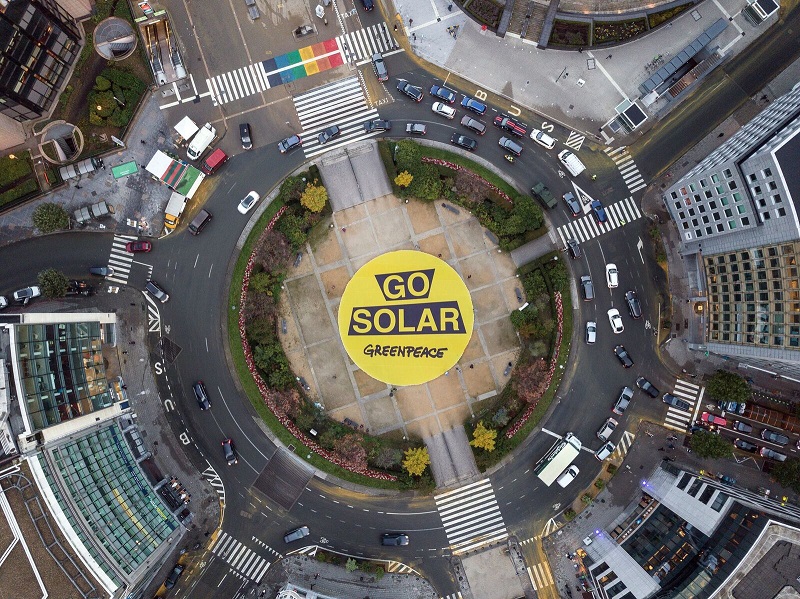Greenpeace, the global environmental organization, has ramped up its calls for the European Union (EU) to adopt greater renewable energy deployment targets through its new ‘Go Solar’ campaign.
The most visceral step taken by the eco-activists came this week in Brussels, when 65 Greenpeace members etched a giant sun on the city’s Schuman roundtable with biodegradable yellow paint. The stunt, which occurred directly outside the headquarters of the European Commission, was one of seven eye-catching actions taken by Greenpeace across many of Europe’s largest cities over the past few days.

Large suns were also unfurled in Budapest, Barcelona, Ljubljana, Sibiu, Zadar and Pernik. Greenpeace says that the campaign has been timed to remind Europe’s MEPs that the continent has an abundance of renewable energy that is waiting to be harnessed. The European Union is currently deciding the future of Europe’s energy system and will vote on a series of wide-ranging policies and legislation on November 28. A reform of Europe’s electricity market rules is due on December 11, with a full Parliament vote expected in early 2018.
“Ordinary people, cooperatives and small businesses are all ready to take part in the energy revolution, making electricity from wind, water and sunlight,” said Greenpeace EU energy policy advisor Ansgar Kiene. “It is time for the EU to wrest the energy system away from a few large corporate players invested in dirty fuels like coal, and give control to the people.”
A decentralized energy system across Europe will require vast amounts of additional solar power. Despite the EU’s renewable targets, growth in deployment has slowed in recent years as previously generous subsidy schemes such as FITs have been closed or scaled back across the continent.
However, given the tumbling costs of solar components, nations such as France, Spain and the Netherlands have this year introduced clean power auctions that should deliver a PV development boost.
pv magazine asked Greenpeace’s energy and climate policy expert Tara Connolly why the environmental group has decided to now pursue solar development in Europe with such gusto.
“We are trying to reach EU energy ministers and MEPs as well as the European Commission,” Connolly told pv magazine. “The EU is currently discussing a package of power market reforms that have big implications for the future of renewables, including solar PV, in Europe. We want to make sure these reforms will accelerate the transition to 100% renewables in the next decade and help empower European citizens to participate in, and benefit from, the energy transition. Europe needs to move from a system with dirty energy in the hands of the few to one with renewable energy in the hands of the many.”
pv magazine: Why do you believe this particular course of action – big yellow suns in prominent landmarks – can have an impact?
Connolly: In 2015, during the UN climate conference, we painted Place de l’Etoile in Paris yellow to symbolize Europe’s fight against climate change. It is a symbol of the abundance of renewable energy sources, including solar power, that Europe should be harnessing instead of using harmful fossil fuels like coal and gas, and nuclear power. We wanted to remind EU leaders both of their commitments to fight climate change, and of the solution to our energy crisis.
Why has Greenpeace chosen to focus on solar in particular? Can you talk a little about the reasons behind identifying solar as the go-to technology that could transform Europe’s energy mix?
Along with wind, we believe that solar power has the biggest potential to accelerate in Europe over the next decade. We also need to develop other renewable energy technologies into the future to help achieve a European energy system based on 100% renewables.
We also chose solar because we are campaigning for the rights of European citizens to invest in renewable energy technologies, generate and sell this renewable electricity into the grid and reap the financial benefits of the energy transition. Solar PV is one of the best technologies for European citizens to invest in due to its scalability and ability to fit well into both the urban and rural environment when done at the smaller scale.
This content is protected by copyright and may not be reused. If you want to cooperate with us and would like to reuse some of our content, please contact: editors@pv-magazine.com.



By submitting this form you agree to pv magazine using your data for the purposes of publishing your comment.
Your personal data will only be disclosed or otherwise transmitted to third parties for the purposes of spam filtering or if this is necessary for technical maintenance of the website. Any other transfer to third parties will not take place unless this is justified on the basis of applicable data protection regulations or if pv magazine is legally obliged to do so.
You may revoke this consent at any time with effect for the future, in which case your personal data will be deleted immediately. Otherwise, your data will be deleted if pv magazine has processed your request or the purpose of data storage is fulfilled.
Further information on data privacy can be found in our Data Protection Policy.